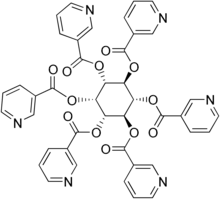Inositol nicotinate
 | |
| Clinical data | |
|---|---|
| AHFS/Drugs.com | International Drug Names |
| Routes of administration | oral |
| ATC code | |
| Legal status | |
| Legal status |
|
| Identifiers | |
IUPAC name
| |
| CAS Number | |
| PubChem CID | |
| ChemSpider | |
| UNII | |
| KEGG | |
| CompTox Dashboard (EPA) | |
| ECHA InfoCard | 100.026.806 |
| Chemical and physical data | |
| Formula | C42H30N6O12 |
| Molar mass | 810.732 g·mol−1 |
| 3D model (JSmol) | |
| Melting point | 255 °C (491 °F) |
SMILES
| |
Inositol nicotinate, also called inositol hexanicotinate, is marketed in the United States as a "no-flush niacin" dietary supplement.[1] Flushing, in physiology, essentially means that epidermal tissues have become reddened, such as when the skin is irritated from the histamine responses related to an allergic reaction, or from recent physical exercise, or even from anger or embarrassment. This form of niacin is supposed to reduce or prevent flushing by being broken down into the metabolites niacin (nicotinic acid) and inositol at a slow rate.[1]
See also
- Esterification
- Hydrolysis
References
- 1 2 Taheri R (15 January 2003). "No-Flush Niacin for the Treatment of Hyperlipidemia". Medscape.com. Retrieved 14 September 2010.
This article is issued from Offline. The text is licensed under Creative Commons - Attribution - Sharealike. Additional terms may apply for the media files.